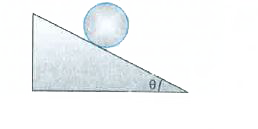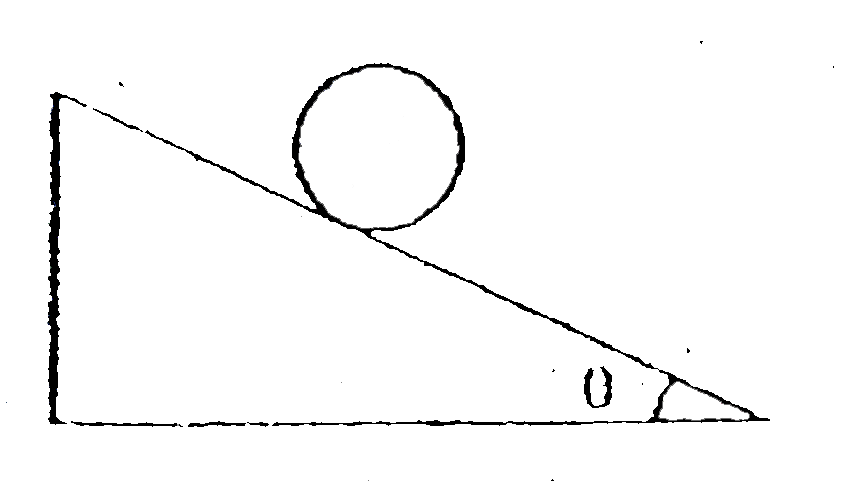An inclined plane makes an angle 30° with the horizontal. A solid sphere rolling down this inclined plane from rest without slipping has a linear acceleration equal to
g3
2g3
5g7
5g14
To solve the problem of a solid sphere rolling down an inclined plane without slipping, we can follow these steps:
Step 1: Identify the forces acting on the sphere
- The weight of the sphere mg acts vertically downward.
- The component of the weight acting parallel to the incline is mgsinθ.
- The component of the weight acting perpendicular to the incline is mgcosθ.
- The frictional force f acts up the incline to prevent slipping.
Step 2: Write the equations of motion
Using Newton's second law for linear motion along the incline:
mgsinθ−f=ma(1)
where a is the linear acceleration of the sphere.
Step 3: Write the rotational motion equation
For the rotational motion about the center of mass, we have:
f⋅r=I⋅α(2)
where:
- I is the moment of inertia of the sphere, given by I=25mr2.
- α is the angular acceleration, related to linear acceleration by α=ar.
Step 4: Substitute α in the rotational equation
Substituting α into equation (2):
f⋅r=(25mr2)⋅(ar)
This simplifies to:
f⋅r=25mar
Dividing both sides by r:
f=25ma(3)
Step 5: Substitute f back into the linear motion equation
Now, substitute equation (3) into equation (1):
mgsinθ−25ma=ma
Rearranging gives:
mgsinθ=ma+25ma
mgsinθ=(1+25)ma
mgsinθ=75ma
Step 6: Solve for acceleration a
Now we can solve for a:
a=57gsinθ
Given that θ=30∘, we have:
sin30∘=12
Substituting this value in:
a=57g⋅12=5g14
Final Answer
Thus, the linear acceleration of the sphere is:
5g14
- The weight of the sphere mg acts vertically downward.
- The component of the weight acting parallel to the incline is mgsinθ.
- The component of the weight acting perpendicular to the incline is mgcosθ.
- The frictional force f acts up the incline to prevent slipping.
Using Newton's second law for linear motion along the incline:
mgsinθ−f=ma(1)
where a is the linear acceleration of the sphere.
For the rotational motion about the center of mass, we have:
f⋅r=I⋅α(2)
where:
- I is the moment of inertia of the sphere, given by I=25mr2.
- α is the angular acceleration, related to linear acceleration by α=ar.
Substituting α into equation (2):
f⋅r=(25mr2)⋅(ar)
This simplifies to:
f⋅r=25mar
Dividing both sides by r:
f=25ma(3)
Now, substitute equation (3) into equation (1):
mgsinθ−25ma=ma
Rearranging gives:
mgsinθ=ma+25ma
mgsinθ=(1+25)ma
mgsinθ=75ma
Now we can solve for a:
a=57gsinθ
Given that θ=30∘, we have:
sin30∘=12
Substituting this value in:
a=57g⋅12=5g14
Thus, the linear acceleration of the sphere is:
5g14
Similar Questions
Knowledge Check
An inclined plane makes an angle 30° with the horizontal. A solid sphere rolling down this inclined plane from rest without slipping has a linear acceleration equal to
Ag3B2g3C5g7D5g14An inclined plane makes an angle of 60∘ with horizontal. A disc rolling down this inclined plane without slipping has a linear acceleration equal to
Ag3B34gCg√3Dg2An inclined plane makes an angle 30° with the horizontal. A solid sphere rolling down this inclined plane from rest without slipping has a linear acceleration equal to
A5g14B2g3C23D5g7
A solid cylinder is rolling down the inclined plane without slipping. Which of the following isare correct?

View SolutionA solid cylinder is rolling down the inclined plane without slipping. Which of the following is correct?

View SolutionThe speed of a homogenous solid sphere after rolling down an inclined plane of vertical height h from rest without sliding is
View SolutionA plane srface is inclined at an angle θ. A cube slides down the plane and a solid sphere rolls down the plane without slipping. The ratio of the acceleration of the cube to that of the sphere is
View SolutionA thin uniform circular ring is rolling down an inclined plane of inclination 30∘ without slipping. Its linear acceleration along the inclined plane will be
View Solution

